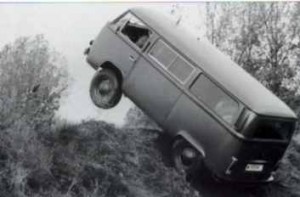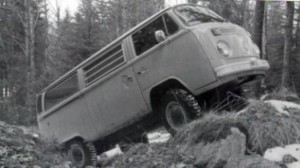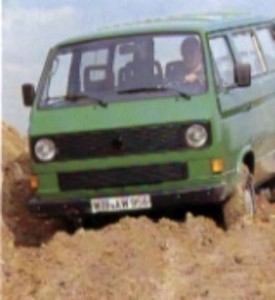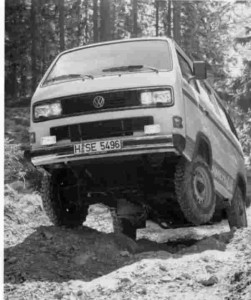by Simon Holloway
VW developed 4-wheel drive on both Beetles (Type 86 – Kommanderwagen) & (Type 128 “Schwimmwagens”) during the Second World War. It took nearly another 40 years before they ventured into this field again.
During the 1970’s a couple of VW engineers who both liked to travel in their Westfalia campers to far off inhospitable regions of Africa & Europe decided it might be a good thing if VW revisited 4WD & developed some vehicles capable of getting further than existing models were able to & seriously competing with the existing 4WD market.
They were ideally placed to do this; Gustav Meyer was head of VW Light truck engineering & Henning Duckstien was in charge of the truck testing department.
Money for research was tight in those days (as the T25 was being developed) but between them they managed to produce five prototype 4WD Bay window transporters using a lot of parts from other vehicles. The driver for this was that if VW could produce a good 4WD drive vehicle & be seen to be competing (or supplying support vehicles) for the tough African rallies then this would attract orders for transporters from the armed forces.
The first of the five prototypes was completed at the end of 1975. The vehicles had semi automatic gearboxes similar to the “Stick Shift” Beetles. These were coupled via a torque converter and a hydraulic clutch to a 70BHP 2-litre engine, which had just been developed for the VW/Audi military “Iltis” vehicle. The system had friction type diff locks & an extra lever in the cab allowed it to be driven in either 2 or 4 wheel drive. Extensive modification was required to the front axle to accommodate the differential & drive shafts (and rerouting of the heating system). These vehicles had drum brakes all round.
Under body plating was applied & the exhaust was modified (tailpipe through bumper!) to give extra ground clearance. Addition of 16” wheels also helped increase ground clearance.
The 5 prototypes undertook extensive testing & produced very positive results.
 |
 |
The exhaust was raised and exited from right corner of bumper
However the project was already attracting a lot of resistance from within VW itself. Amazingly the VW marketing guru’s did not believe there was a market for 4WD utility vehicles in the future – not one of their best marketing decisions!!
Despite this Gustav & Henning managed keep their enthusiasm & continued the project.
At the launch of the Audi built “ Iltis” in 1978 a Bay 4WD prototype was also present. During trials before the German Armed Forces the Bay 4WD ran rings around the Iltis. Despite this the VW Chiefs still decided that the vehicle would not go into series production.
Significantly Ferdinand Piech, (then head of technology with Audi – later boss of VW) was at that demonstration & also saw other film & pictures of the prototypes performance during testing & during its expeditions to the Sahara & as a support vehicle for the Audi Quattro.
 |
 |
Meanest looking bay window ever produced
They also performed as well as they looked but unfortunately appeared at just the wrong time as VW’s attention had switched to the introduction of the T25.

At least one air-cooled T25 vehicle was produced in 1982 as a prototype expedition backup vehicle.
The introduction in 1983 of the water-cooled engined vehicles to the Type 25 range allowed VW to have another rethink about four-wheel drive. This time though VW decided that they would not further develop their Bay Window 4WD design or even use the well tested “Quattro” system already installed on their sister companies Audi range.
Instead they went for a completely new and different “Ferguson” system (originally invented by a Briton) was used on Jensen cars and well tried out on the racetracks. Volkswagen took this system to an Austrian company Steyr-Daimler-Puch, who were already well known in the four-wheel drive “field” for their “Haflinger” and Mercedes “G-Wagen” developments. This was part of a deal for which VW in return would supply LT Diesel engines for their “ Pinzgauer” 6×6 vehicles (that is something else in a different league)
Haflingers were once described to me by Richard Norman of the Haflinger Club (who uses a Syncro Pickup to transport his about) as being the most fun you can get with your trousers on. Its nearly true! For more info on Haflingers etc )
In the spring of 1985 the first Syncro Transporters started to appear. Initially only 2 engine options were available; the 1.9 litre 78 bhp petrol & 1.6 litre 70bhp turbo diesel.
 |
 |
More fun than the shopping run
The 112 bhp 2.1 litre engine was still being developed & was introduced later for the 1986 model year just in time to go on sale in the UK. The 2.1 litre engine was also fitted with a catalyser on many vehicles. This reduced BHP to from 112 to 95. The load and towing capability of these vehicles was very impressive. Road handling was/is just perfect. Once again VW managed to produce a perfectly balanced (50/50) vehicle. Something few vans produced today can boast.
 Sahara Syncro |
 A Syncro for sneaking up on zebras |
Four-wheel drive versions of all models were available but sales were disappointing. There were several reasons for this.
Although the vehicle itself was exceptionally good it was expensive. This was mainly down to the logistics of the manufacturing process, which involved a lot of transportation. Initially, body shells from the Hanover works were delivered to the Steyer-Daimler-Puch works @ Graz in Austria to be fitted with their 4WD train. They were then shipped back to Hanover to be finished off. Vehicles destined to be campers were then shipped off again to the Westfalia works @ Wiedenbruk.
 |
 Mud plugging syncro |
 |
No problem changing wheels on a syncro!
In the late 1980’s the entire T25 production line (including standard vehicles) was switched to the Graz works in Austria to make way for the introduction of the T4 Transporter due to start in the summer of 1990. Some of these vehicles including Syncros were exported to be assembled as “Knock down Kits” in other locations (in particular Japan).
In the UK syncro models were £3500 – £3800 more expensive than the standard transporters which at a price of £13,000 – £15300 when introduced in 1986 made many people look elsewhere for cheaper vehicles. Although the range of vehicles was very impressive they were let down by their engine range. The Syncro was a vehicle ideally suited & aimed at the service sector (in particular rescue services and the military).

Syncro GL with 114 Brake horsepower!
Most of these services wanted much more powerful diesel engines than the pitiful 70 BHP offered by the golf turbo diesel unit being fitted to the VW transporter. Consequently sales of Syncros in this sector were very disappointing.
Of course, the one area that VW completely missed the boat was the leisure market. If their marketing department had seen what was coming I’m sure they would have continued to develop the vehicle and would now be the market leaders in 4WD utility vehicles rather than now trying again to get back into it with the Touareg, a “new luxury off roader” poor relation in people & load carrying practical terms compared with the Syncro!
 |
However Syncros continue to have their fans all over the world. In the early 1990’s the Syncros were very favoured rally vehicles. |

Fly syncro
